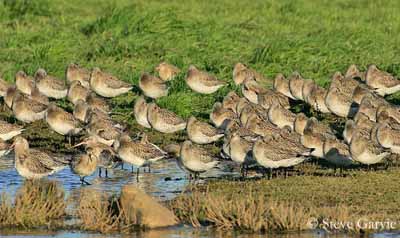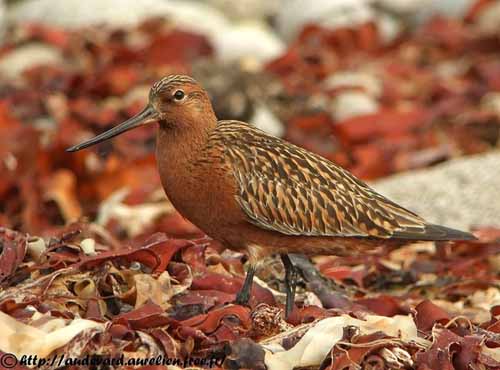
Ang : Bar-tailed Godwit
All : Pfuhlschnepfe
Esp: Aguja Colipinta
Ital: Pittima minore
Nd: Rosse Grutto
Sd: Myrspov
Photographers:
Aurélien Audevard
OUESSANT DIGISCOPING
Steve Garvie
RAINBIRDER Photo galleries
Texte de Nicole Bouglouan
Sources:
HANDBOOK OF THE BIRDS OF THE WORLD Volume 3 by Josep del Hoyo-Andrew Elliott-Jordi Sargatal - Lynx Edicions - ISBN : 8487334202
THE HANDBOOK OF BIRD IDENTIFICATION FOR EUROPE AND THE WESTERN PALEARCTIC by Mark Beaman, Steve Madge - C.Helm - ISBN: 0713639601
THE COMPLETE BOOK OF BRITISH BIRDS – Written by “Royal Society for the Protection of Birds” experts - Préface de Magnus Magnusson - Michael Cady- Rob Hume Editors - ISBN: 0749509112
SHOREBIRDS by Peter Hayman, John Marchant and Tony Prater – Christopher Helm – 1986 – ISBN: 0747014035
GUIDE DES LIMICOLES de D. Taylor - Delachaux et Niestlé - ISBN : 2603014080
BirdLife International (BirdLife International)
Bar-tailed Godwit
Limosa lapponica
Charadriiforme Order – Scolopacidae Family
BIOMETRICS:
Length: 37-41 cm
Wingspan: 70-80 cm
Weight: M: 190-400 g – F: 260-630 g
DESCRIPTION:
The Bar-tailed Godwit adult male in summer plumage has unbarred brick-red underparts and whitish undertail-coverts.
Upperparts are reddish-brown fringed chestnut and mottled grey. The white tail is barred dark.
Head is reddish-brown with pale eyebrow. The long, slender, slightly upturned bill is dark, with pinkish base of lower mandible. Eyes are dark brown. Legs and feet are dark grey.

Bar-tailed Godwit adult male in winter lacks reddish tones. It has grey plumage with white edges on upperparts, and white underparts except the breast which is greyish, with fine dark streaks.
Head is greyish with white supercilium and dark eye-line. Bill is pink at base with black tip.
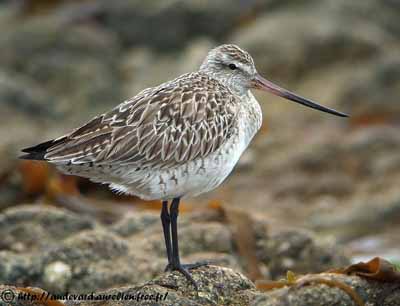
In flight, we can see a white patch from rump to the back, extending in a point in the upper back.
Both sexes are similar, but female is larger than male with longer bill. In summer plumage, she is paler than male and may lack reddish colours.
Juvenile is similar to adult in winter, with heavy black and white markings on wing coverts, and browner or grey upperparts.
Bar-tailed Godwit is difficult to distinguish from the Black-tailed Godwit (Limosa limosa). This one lacks white underwing and has black tail, larger bill and white wing bars.
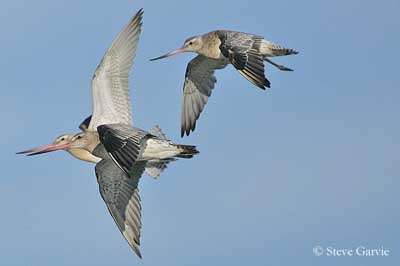
There are three subspecies:
L.l. baueri, larger, with heavily barred rump and lower back. It breeds in eastern Russia and western Alaska, and it winters in eastern Australia and mainly New Zealand.
L.l. menzbieri, is slightly smaller with less extensive barring. Male appears relatively small, with shorter bill and very deep dark red on underparts. It breeds in northern Siberia, and it winters in southeast China, Thailand, Indonesia and northwest Australia.
L.l. lapponica breeds in Scandinavia and western Russia, and winters in north Western Europe, south to Spain and Portugal.
VOICE: SOUNDS BY XENO-CANTO
The Bar-tailed Godwit’s call in flight is a high-pitched “kik” or “kiv-ik” repeated when the bird is excited or alarmed. We can also hear a nasal “ke-wuh”. In flight displays and on breeding areas, they utter various calls such as “a-wik…, a-wik…, a-wik” soft and rapid, and a “ku-wew, ku-wew”.
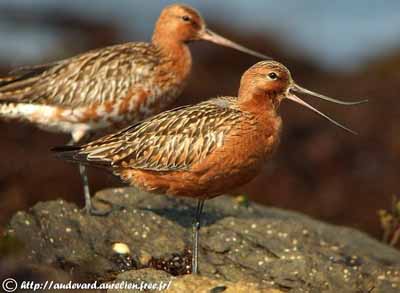
HABITAT:
The Bar-tailed Godwit breeds in wet grassy open tundra, with trees at the edges. Outside breeding season, it lives in sandy estuaries, shallow bays, but also estuaries with firm mud. We can find them in adjacent brackish meadows.
RANGE:
The Bar-tailed Godwit breeds in arctic Asia and western Alaska. They migrate to coastal Western Europe, Africa, South Asia, Australia and New Zealand. Some birds from Europe and Asia may appear on North American coasts.
Bar-tailed Godwit is the holder of the longest non-stop flight known, with about 11000 km from Alaska to New Zealand. It may cover at least 25000 km per year.
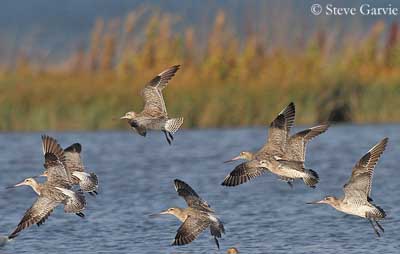
BEHAVIOUR:
The Bar-tailed Godwit feeds in shallow water. It walks slowly and wades through the water, probing by quick jabbing into the mud with its long sensitive bill to find its food. They may feed in flocks of up to 30 or more birds, including migrants (non breeding) and young birds. This species is gregarious, often found in large flocks with other waders. They may also feed in short vegetation where they pick up insects by sight.
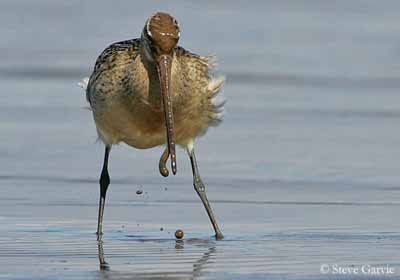
Within typical groups along beaches, the females feed in deeper water than male. They have longer bills and they are larger. Flocks are often at tidal edge, where food resources are most available.
During the courtship displays, the male performs flight displays, circling high above the tundra and the nest site. During these flights, it calls loudly. It also performs territorial displays.
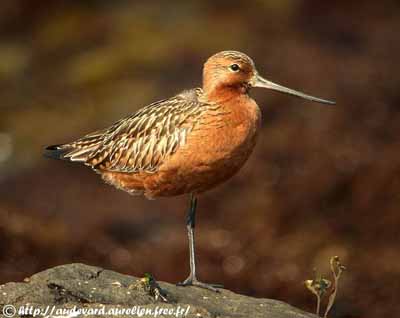
Bar-tailed Godwits are very long distance migrants, with a long migration unrivalled even by the Arctic Tern. They have fat reserves that may double their weight, because they cannot land on the ocean, and they cannot feed during this period above water.
FLIGHT:
The Bar-tailed Godwit performs direct flight with strong steady wing beats.
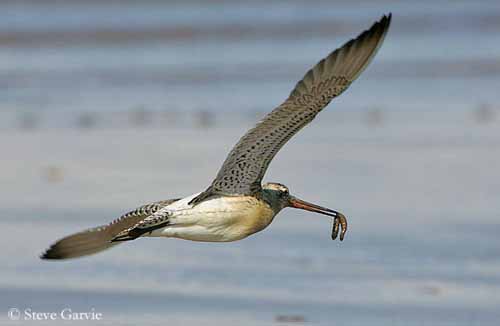
REPRODUCTION:
The Bar-tailed Godwit’s nest is located on the ground, on raised hummock among grass. It is a shallow cup in the moss, and sometimes lined with vegetation such as grass, moss and lichens. They breed on tundra hillsides with short shrubby growth.
Female lays 2 to 4 olive or pale brown eggs, spotted with dark brown. Incubation lasts about 20 to 21 days, shared by both adults. Short time after hatching, the chicks follow their parents to the marshy areas, and they are able to find their own food. Both parents tend and protect them until they fledge, at about one month of age.
The young reach their sexual maturity at two years. This species produces only one brood per season, in May-June.
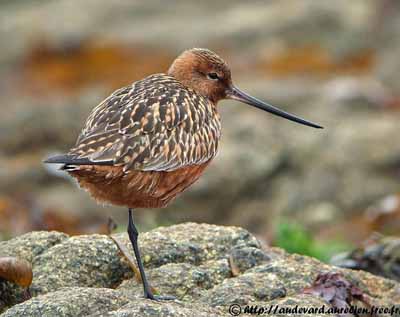
DIET:
The Bar-tailed Godwit feeds on crustaceans, molluscs, insects and annelid worms. According to the habitat, the birds may feed heavily on aquatic insects, and sometimes on seeds and berries.
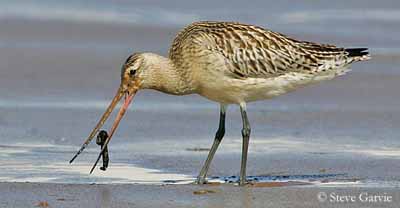
PROTECTION / THREATS / STATUS:
Bar-tailed Godwits are vulnerable to the severity of the weather, habitat loss in coastal places, and hunting in some parts of their migration.
